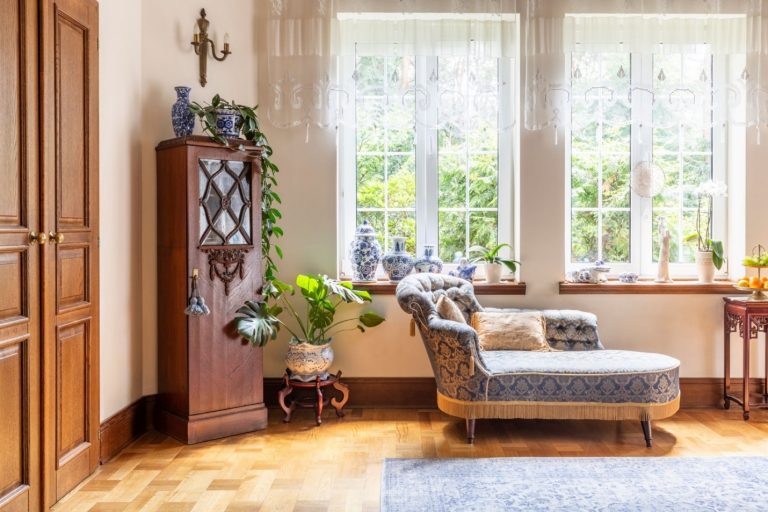Unifying a space doesn’t mean everything has to match! Mixing furniture patterns can bring interest, depth, and personality to any abode, allowing each element in the area to shine and work together.
Though it may seem intimidating–especially if you’re not an interior decorator–asymmetry and pattern mixing are art forms that anyone can master with the right tips.
Let’s dive into the fundamentals of furniture-pattern mixing so you can make decisions that will lead to a well-coordinated space. We’ll also discuss how different types of patterns such as geometric, floral and striped can be used in different areas of your home in creative ways.
Benefits of Pattern Mixing in Furniture
Mixing and matching furniture patterns is a great way to add character, interest, and depth to your space. It’s a creative way to unify a decorating style and gives you the opportunity to showcase your own personal style.
When done correctly, mixing furniture patterns can create an esthetically pleasing atmosphere that feels both fresh and inviting. Plus, it allows you to play with different textures and colors in order to create a unique look. For example, you can mix geometric patterns with florals, or stripes with swirled designs—it’s all up to you!
Just make sure that when you’re mixing patterns you select pieces of furniture with similar scales—a medium scale stripe on one piece of furniture should be balanced out by another medium-scale pattern on another piece. This will help keep your design visually cohesive. Additionally, consider using complementary colors for each pattern so that the overall look is unified.
Looking to add a pop of pattern to your living space? Check out 1StopBedrooms’ patterns furniture collection. Their furniture pieces are designed to add visual interest and personality to any room, from bold patterned chairs to unique patterned ottomans. For further information, read reviews here.
Utilizing Different Patterns in Furniture: Stripes, Florals, and Geometric
Mixing patterns in your furniture offers a great way to add personality and style to a space, but it can be intimidating to mix the right colors, textures, and patterns in a way that looks intentional and unified.
For starters, there are three main pattern types you can include: Stripes, Florals, and Geometrics. Stripe patterns are often seen as timeless and classic, while floral prints can add femininity or a touch of glamor. Meanwhile, geometric shapes draw the eyes away from any imperfections in the room. To make sure each pattern works together harmoniously, pick three different hues from the same color palette to unify them all.
When it comes to scale, larger patterns work best for large pieces of furniture like couches or armchairs; smaller motifs draw attention to details like accent pillows or small pieces of decor. Selecting the appropriate scale ensures that all elements are clearly visible but still complementary to one another—and don’t forget about texture too! Incorporating different textures is an easy way to add interest and depth without going overboard on patterns.
Consider Texture & Complementary Colors
When creating a cohesive look, texture and color palette can be just as important as patterns. Incorporating texture into your furniture design helps add interest, depth and visual appeal to the room. If you’re looking to mix patterns, pull from the same color palette to ensure a cohesive look. For example, if you like to mix a striped pattern with a floral pattern, pick two colors that work together and use them for both.
For example, blues and whites can be used for both stripes and flowers. You can also combine complementary colors for an extra burst of color that ties the furniture together in design. For instance, pair warm colors like oranges or reds with cool colors like greens or blues in order to create a balanced look.
Finally, play around with different patterns in different scales. Try mixing small-scale prints like gingham or polka dots with larger-scale prints like stripes or florals to add visual interest without becoming overwhelming. A classic black-and-white checkered pattern is always an elegant choice when mixing and matching furniture patterns. Keep these tips in mind when choosing your furniture pieces—mixing patterns doesn’t have to be overwhelming!
Harmonizing Your Room: Making It Feel Cohesive
When it comes to patterning, it’s important to choose a color palette that feels cohesive. By pairing items of different colors but with the same shades and tones, you can create an atmosphere of unity. For example, try having different prints — such as floral, geometric and striped — all in the same color family. A couple of accent pieces in a contrasting hue can help to bring out the beauty of the patterns while grounding them in the overall design scheme.
Adding texture can also help in creating harmony. Include surfaces that have texture and depth, such as tufted upholstered furniture or woven baskets and rugs. This can add dimension between prints and make the room feel more unified and visually engaging.
Conclusion
Furniture pattern mixing can be a great way to add depth, interest, and personality to a space. With the right selection of color palettes, scales, and patterns, you can create a space that looks cohesive and visually pleasing. Remember, the key is to experiment, mix, and match until you find a combination of patterns that works for your space. Have fun and don’t be afraid to express yourself. When done well, furniture pattern mixing can create a space you’ll love for years to come.

